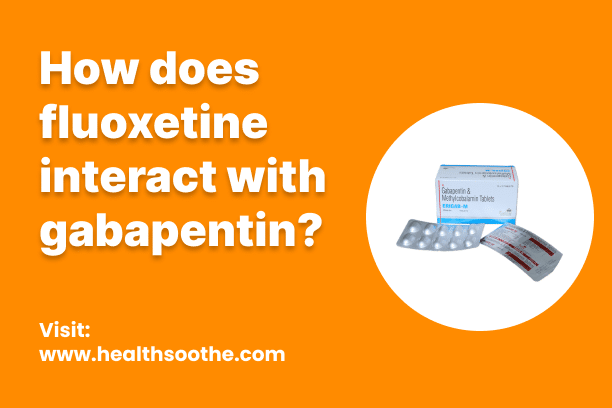This post may contain affiliate links. Read our disclosure policy.
- Gabapentin
- What is gabapentin approved for?
- Pros and Cons of fluoxetine and gabapentin
- Fluoxetine:
- Gabapentin:
- Differences Between fluoxetine and gabapentin
- Fluoxetine:
- Gabapentin:
- Alternative to fluoxetine and gabapentin
- Alternative to fluoxetine
- Alternative to gabapentin
- Interactions between your drugs
- fluoxetine gabapentin
- Drug and food interactions
- fluoxetine food
- gabapentin food
- Conclusion
Fluoxetine is a medication that requires a prescription and is offered in various forms such as capsules, delayed-release capsules, tablets, and solutions, all of which are ingested orally. (Delayed-release capsules are designed to be absorbed into the body at a slower rate.)
The oral capsule form of fluoxetine is marketed under the brand name Prozac, but it is also available in a generic version, which is typically more cost-effective compared to branded versions. However, generic versions may not always be accessible in every strength or form as the branded ones.
Fluoxetine oral capsules may be utilized in combination therapy, necessitating concurrent use with other medications. Specifically, for managing depressive episodes associated with bipolar I disorder and treatment-resistant depression, this medication must be administered alongside olanzapine.
Gabapentin
Gabapentin is a prescribed drug categorized as a gamma-aminobutyric acid (GABA) analogue. GABA functions to decrease the activity of nerve cells (neurons) in the brain, influencing both seizures and the relay of pain signals. Gabapentin imitates GABA's actions, calming overactive neurons.
Gabapentin belongs to the group of medications known as anticonvulsants.
What is gabapentin approved for?
Gabapentin is utilized for the following purposes:
- Preventing and managing partial seizures. It is suitable for use in adults and children aged 3 years and older who experience partial seizures.
- Alleviating nerve pain that occurs after a bout of shingles in adults. Shingles is a painful rash that appears years after having chickenpox. The virus responsible for chickenpox remains inactive in a part of the spinal nerve root known as the dorsal root ganglion. Under certain circumstances, such as stress, this otherwise dormant virus can become active again, resulting in a shingles rash. Nerve pain that follows shingles is termed postherpetic neuralgia (PHN).
- Treating moderate to severe primary restless legs syndrome.
The branded gabapentin products Neurontin and Gralise are authorized for managing partial seizures and PHN. The branded gabapentin enacarbil product Horizant is approved for treating restless legs syndrome and PHN.
Read Also: medications that cause tardive dyskinesia symptoms
Pros and Cons of fluoxetine and gabapentin
Fluoxetine:
Pros:
- Effective for Depression
- Approved for Other Conditions
- Well-Tolerated
- Long Half-Life
Cons:
- Side Effects
- Delayed Onset of Action
- Drug Interactions
- Withdrawal Symptoms
Gabapentin:
Pros:
- Effective for Neuropathic Pain
- Seizure Control
- Off-Label Uses
- Rapid Onset of Action
Cons:
- Side Effects
- Tolerance and Dependence
- Potential for Misuse
- Cognitive Impairment
Differences Between fluoxetine and gabapentin
Fluoxetine:
It is primarily used to treat depression, panic disorder, obsessive-compulsive disorder (OCD), bulimia nervosa, and premenstrual dysphoric disorder (PMDD).
Gabapentin:
It is primarily used to treat neuropathic pain conditions like diabetic neuropathy and postherpetic neuralgia, as well as for controlling seizures in epilepsy.
Alternative to fluoxetine and gabapentin
Alternative to fluoxetine
Sertraline (Zoloft):
Similar to fluoxetine, sertraline is a selective serotonin reuptake inhibitor (SSRI) used to treat depression, anxiety disorders, and other conditions.
Alternative to gabapentin
Pregabalin (Lyrica):
Similar to gabapentin, pregabalin is used for nerve pain (neuropathic pain) and sometimes for certain types of seizures.
Interactions between your drugs
fluoxetine gabapentin
Monitoring is essential when combining anticonvulsants with selective serotonin reuptake inhibitors (SSRIs) or serotonin-norepinephrine reuptake inhibitors (SNRIs), as the effectiveness of anticonvulsants may be reduced. SSRIs and SNRIs, which are antidepressants, can lower the seizure threshold. In clinical studies, convulsions have been observed in approximately 0.1% to 0.3% of patients using SSRIs for major depressive disorders. There have been isolated cases of prolonged seizures in patients receiving electroconvulsive therapy (ECT) while taking fluoxetine.
It's also important to monitor the central nervous system (CNS) adverse effects of anticonvulsants such as drowsiness, cognitive impairment, and psychomotor impairment when SSRIs or SNRIs are coadministered.
Combining SSRIs or SNRIs with certain anticonvulsants, especially carbamazepine, eslicarbazepine, oxcarbazepine, and valproic acid, may increase the risk of hyponatremia. The use of SSRIs or SNRIs has been linked to hyponatremia, possibly due to the syndrome of inappropriate antidiuretic hormone secretion (SIADH) in many cases. Although hyponatremia is usually reversible upon discontinuation of SSRI/SNRI treatment, cases with serum sodium levels below 110 mmol/L have been reported. Hyponatremia and SIADH can also result from treatment with certain anticonvulsants, with a higher risk associated with increased dosage and in elderly patients or those who are volume depleted (e.g., due to diuretic use).
In terms of management, patients with unstable epilepsy should avoid SSRIs and SNRIs, and caution is advised in patients with controlled epilepsy who are using anticonvulsants. Treatment with SSRIs and SNRIs should be stopped if seizures occur or their frequency increases. Patients taking SSRIs or SNRIs along with anticonvulsants, especially carbamazepine, eslicarbazepine, oxcarbazepine, and/or valproic acid, should have their serum sodium levels monitored regularly, particularly with higher dosages. Symptoms of hyponatremia include nausea, vomiting, headache, difficulty concentrating, memory problems, confusion, fatigue, weakness or spasms in muscles, and lack of coordination. In severe cases, hallucinations, fainting, seizures, coma, respiratory failure, and death can occur. Discontinuation of SSRIs and SNRIs should be considered if symptomatic hyponatremia develops, and appropriate medical care should be provided. Patients receiving concurrent treatment with SSRIs or SNRIs and anticonvulsants should be advised against driving, operating machinery, or engaging in potentially risky activities that require alertness and coordination until they understand the effects of these medications on them. They should also inform their doctor if they experience excessive or prolonged CNS effects that interfere with their daily activities.
Drug and food interactions
fluoxetine food
Generally, it's best to steer clear of combining alcohol with medications that affect the central nervous system (CNS). Mixing them can lead to increased CNS depression and may impair judgment, cognitive abilities, and motor skills.
Patients taking CNS-affecting medications should be informed about this interaction and instructed to either avoid alcohol entirely or limit its consumption. Those who are mobile should be advised against engaging in activities that require full mental alertness and motor coordination until they understand the effects of these medications on them. They should also notify their doctor if they experience prolonged or excessive CNS effects that disrupt their daily activities.
gabapentin food
It is generally recommended to refrain from using alcohol with CNS-active medications, as alcohol can amplify the effects of these medications. Combining them may lead to increased depression of the central nervous system and potential impairment of judgment, cognitive function, and motor skills.
Patients who are prescribed CNS-active medications should be informed about this potential interaction and advised to either avoid alcohol entirely or moderate its consumption. Patients who are mobile should also be counseled to steer clear of activities that require full mental alertness and precise motor coordination until they understand how these medications affect them. If patients experience excessive or prolonged CNS-related effects that disrupt their daily activities, they should promptly notify their physician.
Conclusion
The interaction between fluoxetine and gabapentin warrants careful consideration due to their potential to affect each other's pharmacological actions. Fluoxetine, an SSRI antidepressant, has been associated with reducing the seizure threshold, which can be problematic when used concomitantly with gabapentin, an anticonvulsant. This interaction may increase the risk of seizures or exacerbate existing seizure conditions in susceptible individuals. Additionally, both medications can impact the central nervous system, leading to additive effects such as CNS depression and impaired cognitive and motor functions when used together. Therefore, healthcare providers should exercise caution when prescribing fluoxetine and gabapentin concurrently, monitor patients closely for adverse effects, and adjust treatment regimens as necessary to ensure optimal therapeutic outcomes and patient safety.



